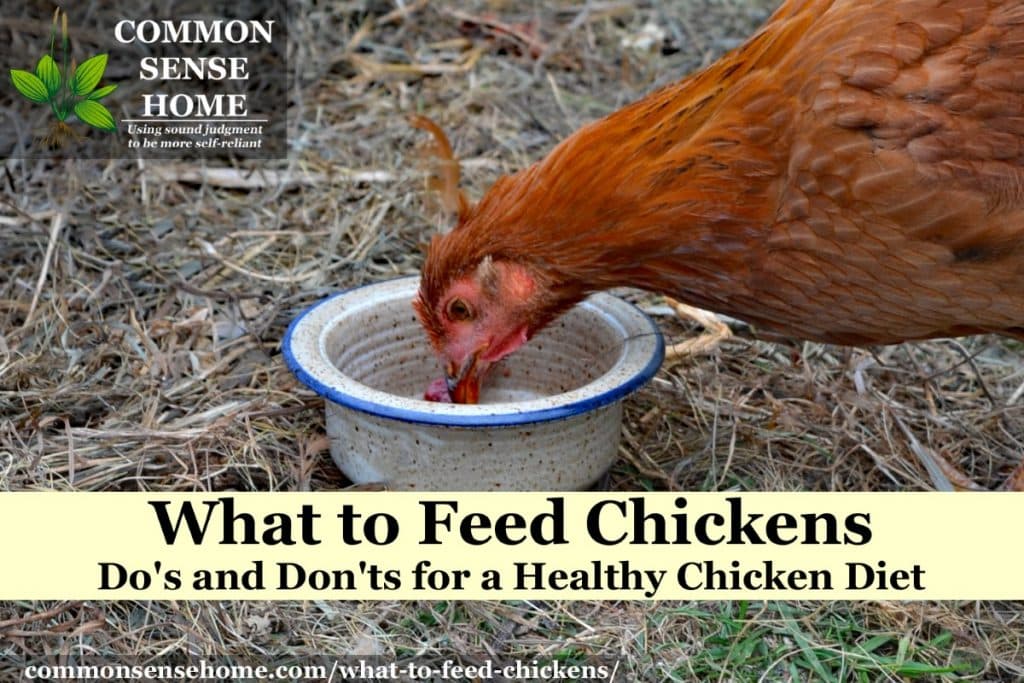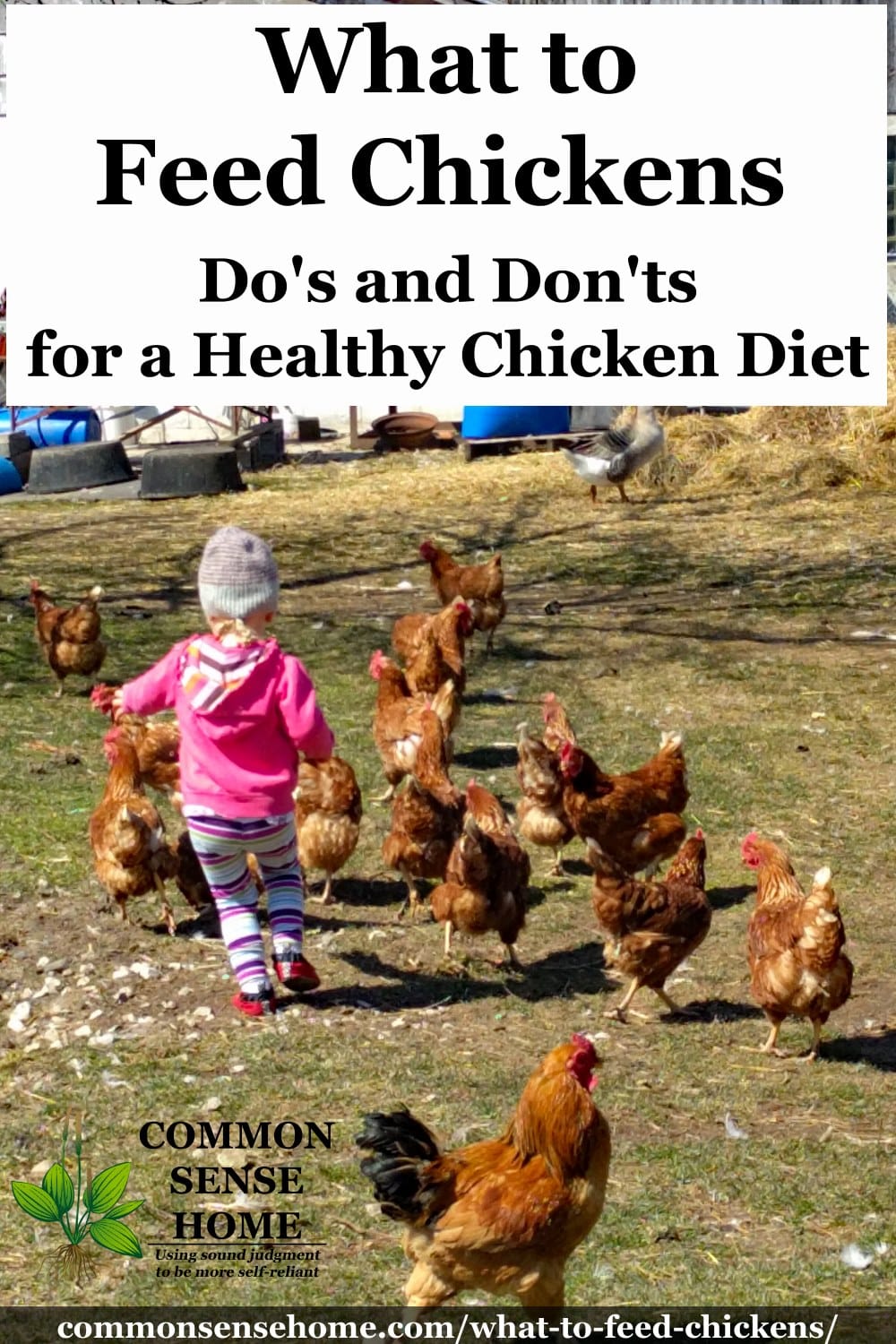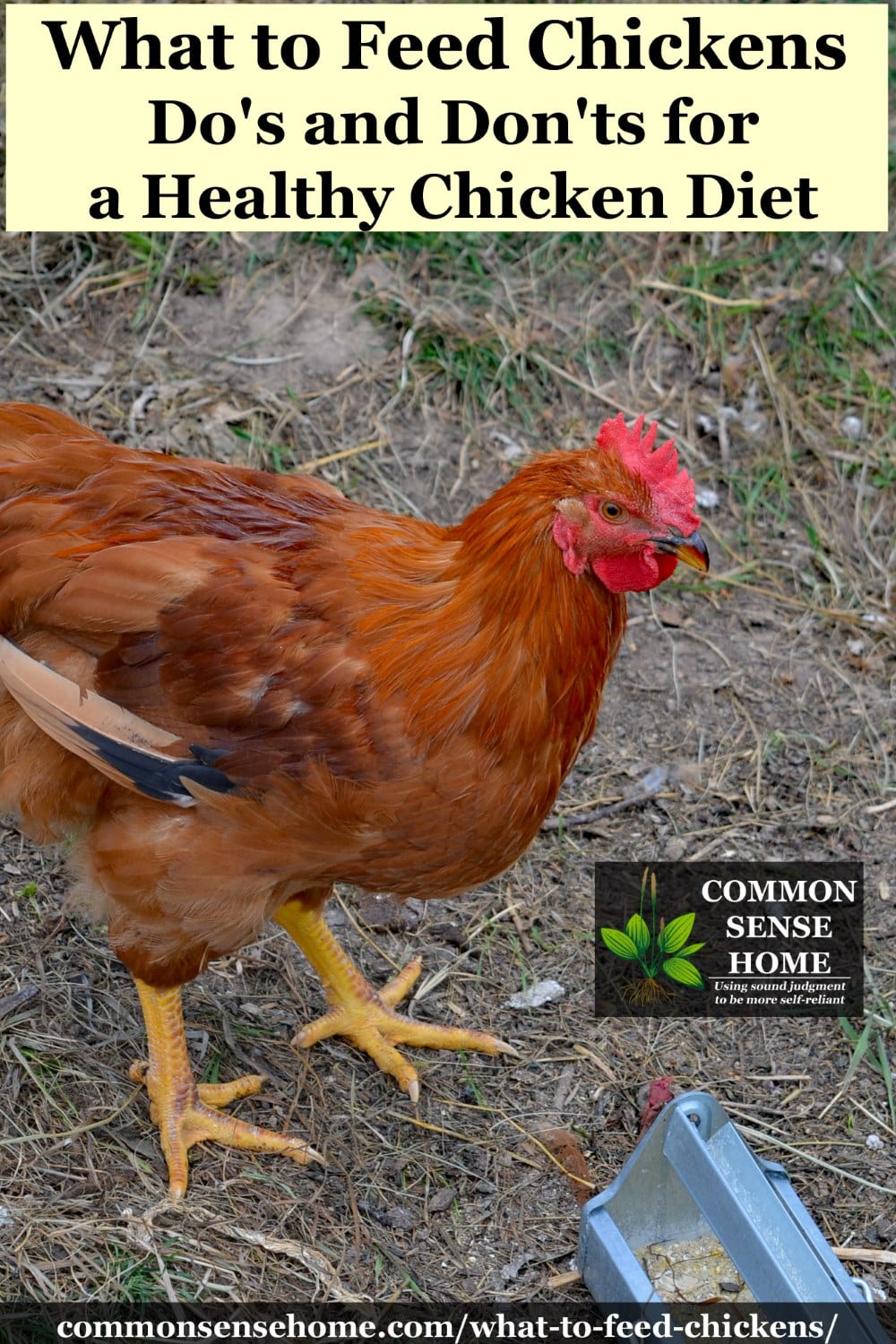What to Feed Chickens – Safe Foods for Chickens
This post may contain affiliate links. Read my full disclosure here.
Why did the chicken cross the road? To get to the pile of interesting scraps on the other side of the road, of course! Commercial producers feed a highly controlled diet to their birds, and there are good reasons for that. Backyard hobbyists and homesteaders love to give treats to their girls. We’ll talk about what to feed chickens and what not to feed chickens to keep your flock happy and healthy.
What’s the Best chicken diet?
The foundational chicken diet depends on species, age of bird, and why you raise them. In general, the faster the growth, the higher the protein requirements. These fast growers would generally be meat birds. For birds intended to be layers or breeders, a slower growth curve is beneficial to give a chance for really robust internal maturation. Actively laying hens need plenty of calcium to support strong shells.
The commercial feed companies have done the research, analyzed the grains and feedstuffs used, and checked on additives such as salt to have optimal growth. I recommend finding a brand that you like and that is readily available, and starting with balanced commercial feed appropriate for your birds. Once you are experienced, you can take the next step with formulating your own rations. You want to achieve at least 16% protein in the ration for layers and 20% or above for a grower feed.
See “The Small-Scale Poultry Flock” by Harvey Ussery for a detailed discussion of chicken diet requirements and spreadsheets to help you calculate feed ratios. Harvey also presents ideas for growing fresh foods such as red worms. See “Vermicomposting – How to Start an Earthworm Bin for Composting” for information on starting your own worm bin.
What to Feed Chickens – Treats and Other Supplements
What else can chickens eat? Remember that everything you feed in essence dilutes your basic ration. These are supplements, not your primary feed.
Some things that are delicious and nutritious for your chickens:
Eggs
Yes, it’s safe for chickens to eat eggs. Do not feed these raw or the hens will develop the bad habit of associating your eggs with their food. We take cracked eggs, found eggs (you know, the ones hiding under the bush because your flock is truly free ranging), and the rare older egg, and scramble them. Wheat germ oil, flax oil, or a source of omega 3s can be added for an extra boost of nutrition. I crush the shells right back into the scrambled concoction.
One note: If using found eggs, float them first to ascertain freshness and avoid unpleasant surprises! (See below.)
What is the float test for egg freshness?
The float test for freshness of eggs works off the changes in the air cell in an egg. As an egg ages, the primary change is loss of moisture. The air cell gets bigger as the contents lose moisture. Therefore, a fresh egg will rest on bottom of a container of water. The container must have enough water to submerge the eggs. As the eggs age, first one end of the egg comes up and little by little the air cell becomes like a flotation device until the egg will actually float on the water. Anything that floats gets tossed in the manure pile here –or in a bonfire if we happen to be having one. We all get a kick out of the random POPS that an exploding egg makes! Treat a floating egg with respect, so you don’t find out what the term ‘rotten egg’ means!
Pumpkin and Squash
Pumpkins and squash can be fed raw, but my chickens mostly turn up their beaks at this in favor of cooked. We do feed them the seeds and innards raw though. Cooking achieves a few purposes, making the plant material more digestible as well as more palatable. The raw squash can be picked up at a reasonable price in fall (if not grown at your establishment) and stored for several months in most conditions. Here in the North, a warm squash– not hot or you can actually burn their little beaks— provides an energy boost and the carotenoids keep the yolks nice and orange when the outside greenery is buried under snow.
Dairy Products
Poultry lack the enzyme to digest milk, BUT smaller quantities can still provide some nutrition. I like to occasionally take goat milk and mix it in with the powdery feed that can end up in the bottom of feeders or in the wet feed left after rain. Before the advent of coccidiostats, dairy was suggested as a defense in the research of the day BECAUSE it produced mucous in the digestive tract, possibly protecting the lining from damage from the protozoa.)
If in doubt, ferment or culture. Yogurt and kefir and even cheese are highly loved by chickens and the action of the microbes on the proteins and lactose improve digestibility. In this case, the microbes do the same thing for the chickens that they do for us; probiotics and a properly colonized gut are the first line of defense against disease.
Potatoes
Included on many lists as “toxic for chickens”, we do feed cooked potatoes. We don’t eat potatoes raw and neither should the birdies. You really don’t have to worry, though, because I have yet to see a chicken eat a raw potato except for the teeny, tiny potatoes that fall off of the wash rack. You would never even see spuds that small if you were not growing them. Potatoes contain more nutrition than you might think. While I wouldn’t make them the base of any diet, moderate consumption of the cooked spud is not a problem. Editor’s note: In The Resilient Gardener, the author uses potatoes as a significant portion of her winter duck food ration.
Sweet Potatoes
Cooked, please! Sweet potatoes provide similar benefits to the squash and pumpkin. Cooking softens the cell walls and makes all the orange goodness more readily available. Honestly, have you ever had so many sweet potatoes that you couldn’t eat them yourself?!
Would you like to save this?
Corn
All types of poultry love corn. I think it is like chocolate to them! In summer, the chickens will pick over the cobs to carefully extract the tender kernels. Save the best for yourself, but the overripe cobs do not have to go to waste. In winter, corn provides a high energy supplement, plus can be scattered in the bedding to encourage scratching, thus providing entertainment, exercise, and the service of turning over the bedding.
Corn is vilified because it is so commonly GMO and of cultivation practices that heavily rely on herbicides. I buy organic corn as much as possible to avoid that. It is really an exceptionally palatable and digestible foodstuff. The protein content of corn is only about 8% so it must be kept in moderation, but especially here in the North, the concentrated energy is a good thing!
Grapes
Not cheap, but they are like drugs for your birds! Slightly fermented is all the better. You can even use treats like grapes to do some rudimentary training — obstacle course, anyone?
Cabbage on a String and Other Snacks for Nutrition and Entertainment
Whole cabbages can be suspended by their roots or in a makeshift harness to provide “tether balls” for your chickens. Hanging mesh baskets filled with greens can also be used, or beefy weeds like dandelions. This is especially valuable in winter, because it provides exercise and a snack! Another popular “entertainment treat” is dried mealworms. These are great for when your chickens have limited access to fresh worms and bugs.
What Not to Feed Chickens
CAUTION – WATCH OUT FOR MOLD. Do not feed any product that is growing all but the smallest amount of mold. Chickens can get a condition called aspergillosis, partly because of their unique anatomy including air sacs. We once found a pocket of mold– triple eww! — inside the lung of a turkey. (No, we did not eat that bird!)
For the most part, chickens will not eat what they cannot digest. When you have a compost pile accessible to your flock, you will find various detritus tossed off into the lawn. Onions, citrus rinds, melon rinds, potatoes and potato skins, corn husks, plant stems, carrot tops, solid chunks of hard, raw veggies will be avoided by the chickens. Some of these items will be found on “never feed this to your chickens” lists, but I have found that, for the most part, they just won’t eat them. (There were my daughter-in-law’s chickens that ate the whole green potato plant, but hey– you have to have exceptions to the rule!)
Dried Beans
Dried beans contain hemaglutinin, a plant lectin that can cause clumping of red blood cells and disrupt cell metabolism. Cooking or sprouting destroys that enzyme. Dried peas, however, apparently do not contain this enzyme, and are the base of non-corn, non-soy feeds like Scratch and Peck Organic Feed. My birds are not very fond of dried peas, not even the pigeons who are supposed to love them!
Trees and Ornamental Plants
The same advice goes for trees and ornamental plants. I have never seen chickens eat most of the plants that populate the lists of those bad for your birds. Even the pretty nightshade berries are left alone by all but the most desperate of birds. One list even had rhubarb on it. C’mon! That stuff is not edible to anybody without culinary modification!
Your chickens will dig around it to find bugs and worms way before they touch the plant itself. Leaves of most tree types may have tannins or phytochemicals that would seem to be toxic. However, I have never seen a chicken readily EAT leaves. We even use them in the fall for bedding. The carbon content is a great complement to the high nitrogen droppings of the chickens and the break down very nicely. Your chickens will kick them all over the place, but they won’t eat them! One exception may be the leaves of tree like walnuts. Those I would leave to compost under the tree!
Chocolate and Flours
The only food that I actively avoid for my flock is chocolate. It is safe to say that here, very little chocolate is in danger of being fed to the chickens anyway. I also will not feed a product like flour directly to my birds, partly because of the ooey, gooey mess that wet flour can be. Back in the day, we didn’t have paste at home and would make ‘glue’ from flour and water. No; I am NOT kidding! If I have flour or an old mix, I will actually bake it into something before I feed it.
Don’t Stress About What to Feed Chickens!
Start with a balanced ration, and then relax and enjoy your birds. With very few exceptions, your feathered friends can eat almost the same things that you do. Remember, as in life, moderation is the key.
This post is by Debra Ahrens. Deb is a dear friend of mine who supplies our family with farm fresh eggs and meat. We also support each other’s gardening efforts and go in together on seed orders. When someone with a homestead critter runs into trouble that I haven’t seen before, I call Deb. She and her family have been a blessing to us.
Debra lives with her family on a five acre hobby farm in northeastern Wisconsin which she often describes as ‘short on hobby, long on farm’. Besides the School of Hard Knocks (Life), she attended UW-River Falls, majoring in Dairy Science. Along with her husband Jerry and their three youngest daughters, they raise every kind of domestic poultry known to man, and maybe a few that shouldn’t be known. Their furry animal family includes a flock of Suffolk sheep, dairy goats, a few rabbits, their dog and a lone beef heifer, Thelma. In her spare time, Debra is a poultry and sheep project leader for Kewaunee County 4-H.







Can chickens eat uncooked rice or does it have to be cooked. They love cooked rice and noodles.
Yes, it’s fine to feed them some uncooked rice.
Hi, is it ok to feed chickens crackers or breads?
As long as they are not moldy, yes, that’s fine. As Deb notes in the article, she won’t feed straight flour, but will feed baked goods.
Wow laurie, every time i come across an article on your post you are so inspiring. This is great work. Keep it up and continue your good deeds. There is a lot am learning from your articles. Thank you!
You’re welcome. I’ll let Debra know you appreciate the information.
Awesome article! !! Very VERY informative! Awesome information! ! Thank you so much for sharing your knowledge when you don’t have to! Thank you!
Chickens have their own taste preferences. My experience matched the author’s with only a few variations. Even within the same flock, some birds love X, while the one next to her turns up her beak at it. The cabbage-on-a-string thing has not worked for me. None of them seem to care for cabbage. A real pity this year, as the cabbages did great.
And rhubarb? They were pecking the leaves like crazy. I had to build little fences around the plants. Even then, any leaf near the mesh got hammered. This was the first year any of our chickens showed any interest in rhubarb leaves.
For the past couple winters, I’ve been making some “silage” out of grass clippings to feed them during the winter. The damp clippings kind of ferment in the anaerobic trashbag “silo.” A couple of cups of “silage” every other day or so, went over well with the flock last winter. I just started this winter’s batch.
Keeping up a varied (and inexpensive) diet for them in the winter is a challenge.
Thanks for sharing your experience, Mic. I’ve found that my chooks like sauerkraut better than cabbage, which is a plus because my kraut will last through the winter in a crock in the basement, and the cabbage won’t. My chooks were also underwhelmed with cabbage on a string, but they do sometimes enjoy fresh cabbage leaves. They like kale and chard better than cabbage, in general, but they have moods. Sowthistle and dandelion are almost always a favorite, but during molting they’ve been going gaga for meat scraps and undersized walnuts.
Sauerkraut, eh? Hadn’t tried that. Got a crock of the first batch just about ready to put into jars. Have to try some on the flock and see how they like it. This year’s garden did great for cabbage. It would be nice turn it into chicken food. I like kraut. The dear wife tolerates it. One ‘batch’ is enough for people food for a winter. If the chickens like it, great! I’ll crock up some more!
Thanks for the suggestion.
I tried it this year with our Cornish rocks since some of them were having loose stool issues. I figured if yogurt is good, why not kraut? I also dumped some older chia seeds in that I found in the back of the pantry. You can see them scarfing it down on Instagram video at https://www.instagram.com/p/BYa9CCrALn3/?taken-by=commonsensehome
Do you offer a commercial grit to your chickens? Mine free range every afternoon and evening, so I’m curious if it’s something they can get themselves, or if I need to buy it. I’m brand new to this, so I’d love your advice! Thanks!
Depending on where they free range they should be able to get enough, but grit is cheap, so it’s not a bad idea to have some available free choice if they need it. Layers eat oyster shells both for the extra calcium and the grit, but granite grit will last longer in their digestive tract.